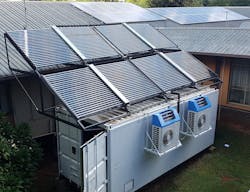Spurred on by a conversation with his father about the expense of operating an electric boiler for hot water, André Nel, founder of South Africa-based Eco-V, set out in search of a solution. That led to a technology, GreenTower, that uses hybrid solar microgrids to treat and heat borehole water.
“The solution we have found a viable financial model for is to combine electricity and water supply,” Nel told Microgrid Knowledge.
GreenTower hybrid solar technology uses heat pumps powered by solar PV supported by direct solar water heating. Combining electricity and water supply, water heating, and energy storage in a microgrid could deliver energy and water security to communities who may not have access to it.
The microgrids harvest and store solar heat energy in insulated tanks, and solar PV electrical energy in lithium ion batteries. A patented method saves up to 90% in electricity for water heating, with excess solar electricity used for other applications. A software management platform enhances Internet of Things (IoT) enabled components.
Since 2014, 20 pilot projects have been implemented to improve and validate the technology.
Working with old age homes
In 2017, Eco-V signed a 10-year service agreement for a GreenTower commercial pilot at an old age home in Pretoria, South Africa. 70 kW solar PV, 26 kWh lithium ion battery, 50 kWth water heating, and 1077 gallons of hot water storage was installed, alongside borehole water production.
Over a one year period, the project reduced energy use by almost 47,000 kWh and saved around 581,178 gallons of municipal water through the use of treated borehole water. The pilot has led to further applications of GreenTower microgrids.
“We are working on implementing the first four of 50 old age homes, then the balance over the next two years as we finalize the financial models for each of the homes,” Nel said.
Nel added that the homes typically house around 80 residents and 60 caregivers, but the microgrids are not limited by scale.
“We’ve developed simulation models to enable us to scale to any size community that uses electricity, energy for heating water, and significant amounts of water… The schools we work on have about 2,000 learners. We’re working with a mine that has 1,600 workers.”
Tackling food security
In addition to energy and water security, there is a drive in Africa towards food security. To tackle this, Eco-V is extending its IoT platform to accommodate aquaponics. These systems raise fish in a controlled environment, and grow plants in the water to take advantage of the natural fertilizer in the fish waste.
Solar powered aquaponics tunnel (Courtesy of Eco-V)
Combining diverse technologies and applications into the microgrid, such as solar PV, aquaponics, solar powered centralized heating and cooling and sewage treatment, can make the economics work while meeting the needs of a community or business.
“The idea is to have a software platform that can accommodate any technology that fits into the business and financial model,” Nel explained.
The company is also engaging with projects outside of South Africa, including others on the African continent and the Middle East.
“We believe that the future of the economy of Africa is tied to the green economy. We need to be more sustainable.”
Track news about microgrids in Africa. Subscribe to the free Microgrid Knowledge newsletter.







